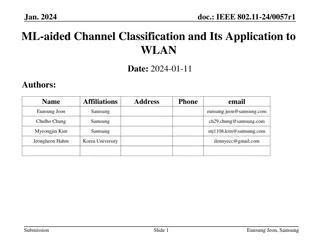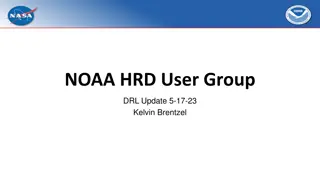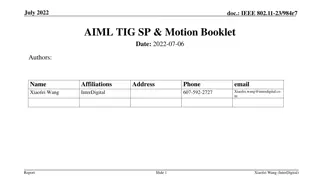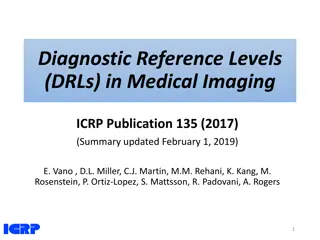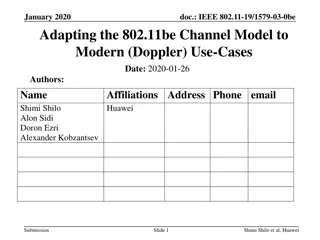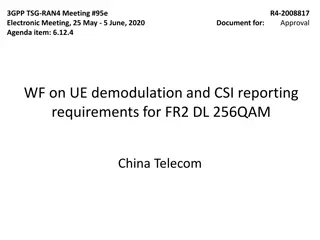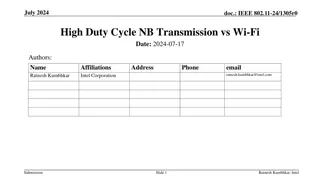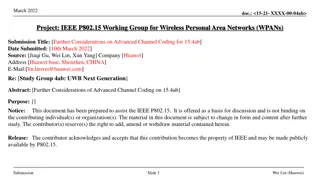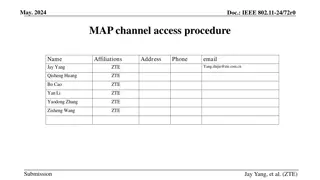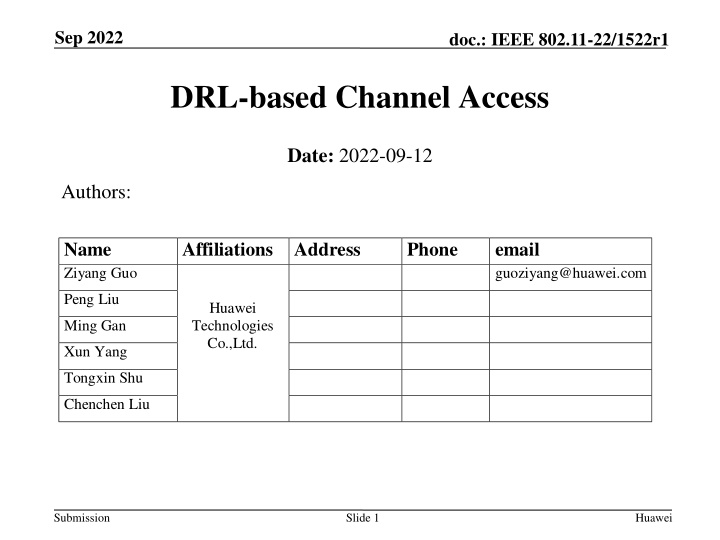
DRL-Based Channel Access in IEEE 802.11-22 Standard
Explore Deep Reinforcement Learning (DRL)-based channel access in the IEEE 802.11-22 standard. Review existing works, performance metrics, neural network models, and standard impacts. Discuss the efficiency and challenges of AI-enabled channel access optimizations. Learn about DRL algorithms and architectures for decision-making in wireless networks.
Download Presentation

Please find below an Image/Link to download the presentation.
The content on the website is provided AS IS for your information and personal use only. It may not be sold, licensed, or shared on other websites without obtaining consent from the author. If you encounter any issues during the download, it is possible that the publisher has removed the file from their server.
You are allowed to download the files provided on this website for personal or commercial use, subject to the condition that they are used lawfully. All files are the property of their respective owners.
The content on the website is provided AS IS for your information and personal use only. It may not be sold, licensed, or shared on other websites without obtaining consent from the author.
E N D
Presentation Transcript
Sep 2022 doc.: IEEE 802.11-22/1522r1 DRL-based Channel Access Date: 2022-09-12 Authors: Name Ziyang Guo Affiliations Address Huawei Technologies Co.,Ltd. Phone email guoziyang@huawei.com Peng Liu Ming Gan Xun Yang Tongxin Shu Chenchen Liu Submission Slide 1 Huawei
Sep 2022 doc.: IEEE 802.11-22/1522r1 Abstract In this contribution, we review the existing works on Deep Reinforcement Learning (DRL)-based channel access, summarize their performance metrics, neural network (NN) models and inputs of NN, discuss their standard impacts. Submission Slide 2 Huawei
Sep 2022 doc.: IEEE 802.11-22/1522r1 Introduction As mentioned in [1], the intrinsic random deferment feature of CSMA/CA makes it upper-bounded by a relative low MAC efficiency [2] and suffers from fairness and latency issues in many realistic scenarios [3]. AI-enabled channel access can be considered as a candidate use case[1] to reduce access delay and jitter, and improve channel efficiency. In [4], channel access optimization via Reinforcement Learning (RL)-based contention window (CW) selection has been discussed, including its challenges and limitations [5]. In this contribution, we focus on the works of DRL-based channel access that directly decide whether to transmit or not, rather than optimizing parameters on top of CSMA/CA. Historical Observation Transmit or Not Neural Network (NN) Submission Slide 3 Huawei
Sep 2022 doc.: IEEE 802.11-22/1522r1 Preliminary Deep Reinforcement Learning: learn the policy that maximizes a long-term reward via interaction with the environment State: ??, Action: ??, Reward: ?? Long-term reward: ?=0 Deep means the policy is parameterized by a NN, learn the policy means to learn the parameters of the NN model, ?: ?? ?? State can be radio measurements, e.g., power, CCA results, PER, or internal parameters in MAC/PHY, e.g., buffer/queue status Reward can be a metric in terms of throughput, delay, fairness ????+?+1,? 0,1 DRL is an efficient AI tool for solving decision-making problems such as channel access, power control, MAC parameter optimization Common DRL Algorithms: DQN (Deep Q Network), QMIX, PPO (Proximal Policy Optimization), DDPG (Deep Deterministic Policy Gradient) Training data for DRL: S?,??,??+1,??+1,??+1,??+2 Submission Slide 4 Huawei
Sep 2022 doc.: IEEE 802.11-22/1522r1 Learning Architecture AP AP: Training AP: Model Average 1 ? Measurement report Assisted info Model i Model ?Model i Non-AP: Training & Inference Non-AP: Training & Inference Non-AP: Inference Distributed Learning Training and Inference @STAs, i.e., Type 1 in [11] Need training capability support Standard impact: -- (maybe) Assisted info to facilitate training or inference Related works on channel access [6] Centralized Learning Training @AP, Inference @STAs i.e., Type 2 in [11] Only AP needs training capability Standard impact: -- (maybe) New measurement report to facilitate training; -- Model deployment Related works on channel access [7] Federated Learning Training and Inference @STAs, i.e., Type 2 in [11] Need training capability support Standard impact: -- Model report -- (averaged) Model deployment Related works on channel access[8] Submission Slide 5 Huawei
Sep 2022 doc.: IEEE 802.11-22/1522r1 Channel Access with Distributed Learning In [6], a DRL-based channel access scheme for heterogeneous wireless networks is proposed, named as Carrier-Sense Deep reinforcement Learning Multiple Access (CS-DLMA). CS-DLMA achieves intelligent coexistence with other MAC protocols, e.g., TDMA, Aloha, Wi-Fi. Performance Evaluation: Individual throughput, sum throughput * Throughput (channel efficiency) is individual throughput. The network throughput is ~8*0.07, ~0.56 Submission Slide 6 Huawei
Sep 2022 doc.: IEEE 802.11-22/1522r1 Channel Access with Distributed Learning AP Assisted info Non-AP: Training & Inference DRL algorithm: DQN [9] Neural Network (NN): LSTM + fully-connected layer Input of NN: a sequence of historical CCA results (Busy or Idle), actions (Transmit or Wait), and transmission results (successful or failed) Standard impact: -- Assisted info for training: Transmission results of other STAs or rewards Submission Slide 7 Huawei
Sep 2022 doc.: IEEE 802.11-22/1522r1 Channel Access with Centralized Learning In [7], a DRL-based channel access scheme with centralized learning architecture is proposed, named as QMIX-advanced Listen-Before-Talk (QLBT). Centralized training maximizes the use of environmental observations Performance Evaluation: Channel efficiency: Outperforms CSMA/CA and even the upper bound [2] (~0.85) Delay: bounded delay under heavy traffic load Submission Slide 8 Huawei
Sep 2022 doc.: IEEE 802.11-22/1522r1 Channel Access with Centralized Learning AP: Training Measurement report Model Non-AP: Inference DRL algorithm: QMIX [10] Neural Network (NN): GRU + fully-connected layer Input of NN: a sequence of historical CCA results (Busy or Idle), actions (Transmit or Wait), and delay to last successful transmission Standard impact: -- Measurement report for training: (from non-AP STAs to AP) S?,??,??+1,??+1, -- Model deployment: (from AP to non-AP STAs) 19.08 KBytes once, 4770 NN parameters and 32 bits for each Submission Slide 9 Huawei
Sep 2022 doc.: IEEE 802.11-22/1522r1 Channel Access with Federated Learning In [8], a DRL-based channel access scheme aided by Federated Learning (FL) is proposed, named as Federated Reinforcement Multiple Access (FRMA). The FL algorithm is applied to achieve fairness among users. Performance Evaluation: Throughput: Outperforms CSMA/CA with/without RTS/CTS Fairness: the proportional fairness among users Submission Slide 10 Huawei
Sep 2022 doc.: IEEE 802.11-22/1522r1 Channel Access with Federated Learning AP: Model Average 1 ? Model i ?Model i Non-AP: Training & Inference DRL algorithm: DQN Neural Network (NN): six fully connected layers with skip connections Input of NN: a sequence of historical CCA results (Busy or Idle) and actions (Transmit or Wait) Standard impact: -- Model report: (from non-AP STAs to AP) 94.216 KBytes once -- Model deployment: (broadcast the averaged model to non-AP STAs) 92.168 KBytes once, 23042 NN parameters and 32 bits for each Submission Slide 11 Huawei
Sep 2022 doc.: IEEE 802.11-22/1522r1 Existing Work Comparison Learning Architecture Related Works Input of NN Performance metric Standard Impact Other requirements Distributed Learning [6] --CCA results (Busy or Idle) --Actions (Transmit or Wait), --Transmission results (successful or failed) --Sum throughput, --Individual throughput, --?-fairness --Transmission results of other STAs or Rewards Non-AP STA needs to support both training and inference Centralized Learning [7] --Delay to last successful transmission --CCA results (Busy or Idle) -- Actions (Transmit or Wait) --Channel efficiency --Delay (mean delay and jitter) --training data: S?,??,??+1,??+1, Non-AP STA only needs to support inference -- Model deployment Federated Learning [8] --CCA results (Busy or Idle) --Actions (Transmit or Wait) --Throughput --Fairness -- Model report -- Model deployment: (broadcast the averaged model to STA) Non-AP STA needs to support both training and inference Transmission Overhead: Federated > Centralized > Distributed Performance: Centralized Federated > Distributed Training Capability of non-AP STAs: Distributed Federated > Centralized Submission Slide 12 Huawei
Sep 2022 doc.: IEEE 802.11-22/1522r1 Summary In this contribution, we have reviewed three works on DRL-based channel access. They all show performance gain compared with CSMA/CA. Channel access can be considered as a good starting use case for Wi- Fi AI. Three learning architectures (distributed, centralized and federated) and their comparisons are discussed. To analyze the standard impacts of DRL-based channel access, different learning architecture need to be discussed separately. Model deployment could be discussed in priority as it has the greatest impact on standardization. Submission Slide 13 Huawei
Sep 2022 doc.: IEEE 802.11-22/1522r1 References [1] 11-22-0458-01-0wng-look-ahead-to-next-generation-follow-up [2] L. Dai and X. Sun, A unified analysis of IEEE 802.11 DCF networks: Stability, throughput, and delay, IEEE Trans. Mobile Comput., vol. 12, no. 8, pp. 1558 1572, Aug. 2013 [3] M. Cagalj, S. Ganeriwal, I. Aad, and J.-P. Hubaux, On selfish behavior in CSMA/CA networks, in Proc. IEEE 24th Annu. Joint Conf. IEEE Comput. Commun. Soc., vol. 4, 2005, pp. 2513 2524. [4] 11-22-0979-01-Applying ML to 802.11: Current Research and Emerging Use Cases [5] S. Szott, M. Natkaniec, and A.R. Pach. "An IEEE 802.11 EDCA model with support for analyzing networks with misbehaving nodes." EURASIP Journal on Wireless Communications and Networking 2010 (2010): 1-13. [6] Y. Yu, S. C. Liew and T. Wang, "Non-Uniform Time-Step Deep Q-Network for Carrier-Sense Multiple Access in Heterogeneous Wireless Networks," in IEEE Transactions on Mobile Computing, vol. 20, no. 9, pp. 2848-2861, 1 Sept. 2021, doi: 10.1109/TMC.2020.2990399. [7] Z. Guo, et al. "Multi-agent reinforcement learning-based distributed channel access for next generation wireless networks." IEEE Journal on Selected Areas in Communications 40.5 (2022): 1587-1599. [8] L. Zhang, et al. "Enhancing WiFi multiple access performance with federated deep reinforcement learning." 2020 IEEE 92nd Vehicular Technology Conference (VTC2020-Fall). IEEE, 2020. [9] V. Mnih et al., Human-level control through deep reinforcement learning, Nature, vol. 518, no. 7540, pp. 529 533, 2015. [10] T. Rashid, M. Samvelyan, C. Schroeder, G. Farquhar, J. Foerster, and S. Whiteson, QMIX: Monotonic value function factorisation for deep multi-agent reinforcement learning, in Proc. Int. Conf. Mach. Learn., 2018, pp. 4295 4304. [11] 11-22-0723-01-0wng-further-discussion-on-next-generation-wlan Submission Slide 14 Huawei





